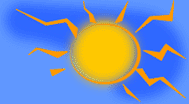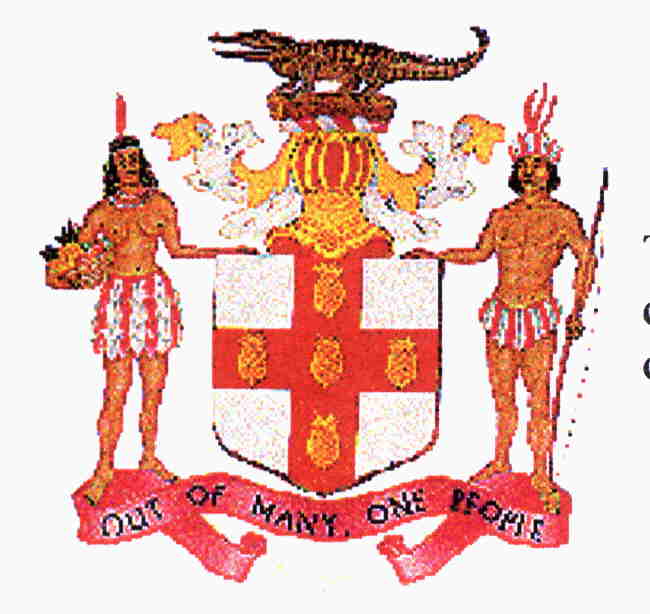|
Jamaican National Symbols
National Flag
The Jamaica National Flag was first raised on Jamaica's Independence Day, August 6, 1962. It signifies the birth of a nation.
A bipartisan committee of the Jamaica House of Representatives designed the Jamaican Flag which consists of a diagonal
cross or satire with four triangles in juxtaposition. The diagonal cross is in gold and one-sixth of the length of the fly
of the flag; the top and bottom triangles are in green; and the hoist and fly triangles are in black. The exact shade of
green used in the flag is Emerald T8 17, British Admiralty Bunting Pattern. The Flag follows the "Admiralty Pattern"
and the proportion is 2 x 1.
"The sun shineth, the land is green and the people are strong and creative" is the symbolism of the colours
of the Flag: Black depicts the strength and creativity of the people; Gold, the natural wealth and beauty of sunlight; and
Green, hope and agricultural resources.

National Coat of Arms & Motto
| Indus Uterque Serviet Uni |
|
|
| "Out of Many, One People" |
The original Coat of Arms granted to Jamaica in 1661, was designed by the then Archbishop of Canterbury, William Sanderoft.
Apart from a partial revision in 1957, it remains virtually the same as was originally designed. The Arms shows a male and
female Arawak, standing on either side of the shield which bears a red cross with five golden pineapples superimposed on it.
The Crest is a Jamaican crocodile surmounting the Royal Helmet and Mantlings. The original Latin motto, "Indus Uterque
Serviet Uni", has been changed to one in English:
"Out of many, one people"
In the early 19th century, however, the people of this Caribbean island were divided by color and class. Most black slaves--treated
more as property than as human beings. In fact, until slavery was abolished in 1838, Jamaica served as the chief slave market
of America. The transformation of the country into a multiracial society with considerable social and political harmony,
therefore is a remarkable achievement.

National Bird
| Trochilus polytmus |
|
|
| "Doctor Bird" |
The "Doctor Bird" (Trochilus polytmus), or swallow tail humming bird, is is one of the most outstanding of the 320
species of hummingbirds. It lives only in Jamaica. These birds' beautiful feathers have no counterpart in the entire bird
population and they produce iridescent colours characteristic only of that family. In addition to these beautiful feathers,
the mature male has two long tails which stream behind him when he flies. For years the doctor bird has been immortalized
in Jamaican folklore and song.
The origin of the name 'Doctor-bird' is somewhat unsettled. It has been said that the name was given because the erect
black crest and tails resemble the top hat and long tail coats doctors used to wear in the old days. Other schools of thought
believe that it refers to the way the bird lance the flowers with their bills to extract nectar.
According to Frederic Cassidy the bird is an object of superstition. The Arawak spread the belief that the bird had magical
powers. They called it the 'God bird', believing it was the reincarnation of dead souls. This is manifested in a folk song
which says: "Doctor Bud a cunny bud, hard bud fe dead". (It is a clever bird which cannot be easily killed).
This bird has been used as the logo for Air Jamaica Airlines and is quite noticeable on the tail end of the airplane.

National Fruit
| Blighia sapida |
|
|
| "Ackee" Vegetable Brain |
"Carry me ackee go a Linstead Market, not a quattie wud sell" is a line in the popular Jamaican folk song 'Linstead
Market'. Ackee is the national fruit of Jamaica as well as a component of the national dish - ackee and salt-fish.
Ackee is derived from the original name Ankye which comes from the Twi language of Ghana. The botanical name of the fruit
- Blighia Sapida - was given in honour of Captain William Bligh of "Mutiny on the Bounty" fame, who in 1793 took
plants of the fruit from Jamaica to England. Captain Bligh also brought the first breadfruit to Jamaica. Before this, the
ackee was unknown to science. In 1778 Dr Thomas Clarke, one of the earliest propagators of the tree, introduced it to the
eastern parishes.
The tree reaches a height of up to 15.24m (50ft) under favourable conditions. The leaves are compound, comprising four
or five pairs of leaflets. The flowers are produced in auxiliary racemes and each blossom is small, greenish white in color
with a pleasant fragrance. The fruits develop thick, reddish-orange skins which enclose shiny, black seeds (three per fruit
body). At the base of the seeds is a fleshy, whitish-colored structure called the aril. This is the only edible part of
the fruit.
Ackee contains a poison (hypogicin) which is dissipated when it is properly harvested and cooked. The fruit should not
be gathered until the pods open naturally. Unripened arils, or those over-ripe, are poisonous and 'Jamaica poisoning' is
the term given to the condition resulting in death which is caused by eating arils at the wrong stage of development.

National Flower
| Guaiacum Officionale Lignum Vitae |
|
|
| "Tree of Life" |
The Lignum Vitae was found by Christopher Columbus. Its name, when translated from Latin, means "wood of life"
- probably adopted because of its medicinal qualities. The short, compact tree is native to continental tropical American
and the West Indies. In Jamaica it grows best in the dry woodland along the north and south coasts of the island.
The plant is extremely ornamental, producing an attractive blue flower and orange-yellow fruit, while its crown has an
attractive rounded shape. The tree is one of the most useful in the world.
This tree grows to a height of between twenty and thirty feet. It produces large numbers of crooked branches and the
rounded, dome-shaped form is very pronounced. Each leaf is composed of two or three pairs of stalk less leaflets which are
glossy and dark green in color. Its abundant flowers which flowers twice a year ranges in color from purple to blue and pale
over time. The fruits are fleshy and orange in color.
The wood was once used as propeller shaft bearings in nearly all the ships sailing the 'Seven Seas'. Because of this,
Lignum Vitae and Jamaica are closely associated in shipyards worldwide. It is a very heavy wood which will sink in water.
It is used in the manufacture of functional parts such as pulley blocks, cogs and bearings.
Gum guaiacum, collected from the bark, has been used in the treatment of arthritis and a decoction of the sap wood are
used, until the development of more modern drugs, in the treatment of syphilis and has also been used as a remedy for gout.
The tree is common in parts of Jamaica (the flower is the national flower of Jamaica).

National Tree
| Hibiscus elatus |
|
|
| "Blue Mahoe" |
The Blue Mahoe is the national tree of Jamaica. It is indigenous to the island and grows quite rapidly, often attaining 20m
(66ft) or more in height. In wetter districts it will grow in a wide range of elevations, and is often used in reforestation.
The tree is quite attractive with its straight trunk, broad green leaves and hibiscus-like flowers. The attractive flower
changes colour as it matures, going from bright yellow to orange red and finally crimson.
The name mahoe is derived from a Carib Indian word. The 'blue' refers to blue-green steaks in the polished wood, giving
it a distinctive appearance.
The Blue Mahoe is so beautiful and durable that it is widely used for cabinet making and also for decorative objects such
as picture frames, bowls and carving.
The inner bark of the tree is often referred to as Cuba bark because it was formerly used for tying bundles of Havana
cigars. Cuba is the only other place where the Blue Mahoe grows naturally.
|









